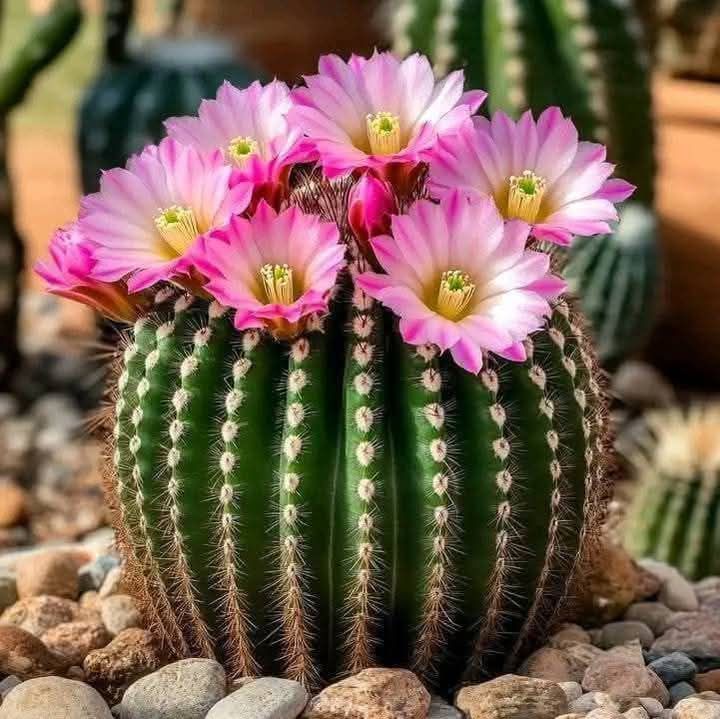The Argentine Giant Cactus (Echinopsis candicans) is a truly impressive and striking plant, known for its towering height and stunning blooms. A fantastic addition to desert gardens, xeriscapes, and other drought-resistant landscapes, this cactus brings an aesthetic elegance and a sense of the wild to any environment. With proper care, the Argentine Giant can thrive and continue to impress for years. In this article, we’ll dive into the details of how to grow, care for, and appreciate this remarkable plant.
What is the Argentine Giant Cactus?
Native to Argentina, the Argentine Giant Cactus is a species of cactus that is known for its towering, columnar form and striking floral displays. Unlike other cacti that remain relatively small or bushy, this cactus grows tall—often reaching heights of 6 to 10 feet (1.8 to 3 meters). Its thick, ribbed stems are a deep green, dotted with short, golden spines, which give it a textured and bold appearance.
But the true highlight of this cactus is its large, beautiful flowers, which bloom in late afternoon and remain open for just a single day. The flowers, which can reach up to 6 inches (15 cm) in diameter, are typically white or pink, adding an eye-catching pop to the cactus’s striking, tall profile.
The Argentine Giant Cactus is not only an attractive plant but also a hardy and low-maintenance option for those looking to add some dramatic flair to their garden or indoor collection. If you live in an area with a dry, hot climate or are looking for a unique feature for your xeriscape, this cactus is the perfect choice.
Benefits of Growing the Argentine Giant Cactus
1. Adds Architectural Appeal to Your Landscape
Due to its large size and unique structure, the Argentine Giant Cactus serves as a focal point in gardens, adding a bold architectural element. It is a great choice for creating a dramatic landscape or accentuating desert or xeriscape designs. Its columnar form and striking ribs make it an attractive and unusual addition to your garden bed or container.
2. Low Maintenance and Water-Efficient
As a cactus, the Argentine Giant thrives in dry conditions and requires very little water. This makes it an excellent plant for water-wise gardening and perfect for areas that are prone to drought. It’s an ideal choice for homeowners who want a beautiful plant but are concerned about conserving water or dealing with the hassle of frequent watering.
3. Attractive Flowers
The large, white or pink flowers of the Argentine Giant Cactus are a standout feature. Although they only bloom for a short time, they are quite the spectacle when they do. These gorgeous blooms can last anywhere from a few hours to a day, attracting pollinators like bees and hummingbirds.
4. Wildlife-Friendly
In addition to attracting pollinators, the Argentine Giant provides shelter for desert wildlife. Birds, small mammals, and insects can all find refuge in its towering presence, making it a key contributor to the local ecosystem, especially in arid regions.
How to Care for the Argentine Giant Cactus
1. Light Requirements
The Argentine Giant Cactus requires full sun to thrive. To promote healthy growth and flowering, this cactus should receive at least 6 hours of direct sunlight each day. Without sufficient light, the cactus may become leggy or fail to produce flowers. If you’re growing it indoors, place it near a south- or west-facing window where it can get the sunlight it needs.
2. Watering Needs
Cacti are known for being drought-tolerant, and the Argentine Giant is no exception. Overwatering is one of the most common mistakes people make with cacti, and it’s important to avoid this at all costs. Allow the soil to fully dry out between waterings, and never leave the plant sitting in water. During the growing season (spring and summer), water the cactus every 2 to 3 weeks. In fall and winter, reduce watering frequency, as the cactus enters a dormant phase.
Always check the soil before watering. The cactus will do best in well-draining soil that allows excess water to escape, preventing root rot. Ensure that your container has drainage holes, and never allow water to accumulate in the bottom.
3. Soil Preferences
The Argentine Giant Cactus thrives in well-draining, sandy soil. It prefers soil with a slightly acidic to neutral pH of 5.5-6.5. You can use a cactus or succulent mix or make your own by combining sand, perlite, and potting soil to create a soil blend that drains quickly.
The cactus needs this specific soil to prevent water from sitting around its roots, which could lead to rot. If planting in the ground, choose a location with loose, well-draining soil to ensure proper root development.
4. Temperature and Humidity
The Argentine Giant Cactus thrives in temperatures between 60–90°F (15–32°C). It is quite adaptable to hot and arid climates, but can also tolerate some cooler conditions. However, the cactus is not frost-hardy and should be protected from freezing temperatures.
If you live in an area where temperatures drop below freezing in winter, it’s best to bring the cactus indoors or cover it with a frost blanket. This will protect it from frost damage during cold spells. When growing indoors, make sure the temperature stays consistent and avoid placing it in a drafty location.
As for humidity, the Argentine Giant Cactus is used to dry, arid environments, so it does not require high humidity levels. In fact, it thrives in low-humidity conditions, and good air circulation is essential to prevent fungal issues or disease. Keep your cactus in a well-ventilated area, especially if grown indoors.
5. Fertilizing
While not a heavy feeder, the Argentine Giant Cactus can benefit from occasional fertilizing. Apply a diluted, balanced cactus fertilizer (such as a 10-10-10 formula) once in spring and again in summer during its growing season. Be careful not to over-fertilize, as too much fertilizer can damage the cactus and prevent it from blooming.
Avoid fertilizing during the fall and winter months when the cactus is dormant.
Common Problems and Troubleshooting
1. Overwatering
One of the most common issues with cacti, including the Argentine Giant, is overwatering. Too much water can cause root rot, leading to the cactus’ eventual decline. Always check the soil before watering and ensure that it is fully dry. Make sure your pot has drainage holes to allow excess water to escape.
2. Pests
While generally pest-resistant, the Argentine Giant Cactus can sometimes attract mealybugs, spider mites, or scale insects. If you notice signs of infestation, such as tiny webs, sticky residue, or discolored spots, treat your cactus with insecticidal soap or neem oil. Be sure to follow the instructions on the label and treat all affected areas.
3. Fungal Diseases
Fungal infections are often the result of overwatering or poor drainage. If you notice any soft spots or discoloration on the cactus, remove the affected area and ensure the plant is placed in a well-draining environment. Fungal issues can be prevented by ensuring the cactus has proper air circulation and by avoiding excessive moisture around the roots.
Conclusion
The Argentine Giant Cactus is a stunning and unique plant that brings an architectural appeal and striking floral beauty to your garden. With its large size, beautiful blooms, and low-maintenance care, it’s an excellent choice for anyone looking to add a bold, drought-tolerant plant to their collection. By following the simple care guidelines outlined in this article, you can enjoy the beauty of this majestic cactus for many years to come. Whether you’re growing it indoors or in a desert garden, the Argentine Giant will surely become a standout feature in your landscape.
Add the Argentine Giant Cactus to your garden today and let its grandeur and beauty transform your space! 🌵💐
More Articles You Might Like
-
Texas Toast Sloppy Joes: The Crunchy, Cheesy Upgrade You Didn’t Know You Needed
There’s something timeless about sloppy joes. For generations, this saucy, savory, and slightly sweet ground beef sandwich has been a go-to comfort food in American kitchens. It’s quick, filling, and family-friendly—perfect for busy weeknights. But what if we told you there’s a way to take this classic dish up a notch? Enter the Texas Toast…
-
Classic Pig Pickin’ Cake
When it comes to Southern desserts, few sweets shine as brightly as the Classic Pig Pickin’ Cake. This nostalgic cake, sometimes called a “Mandarin Orange Cake,” has roots deep in Southern tradition. It gets its playful name from its frequent appearance at pig pickin’s—Southern-style barbecue gatherings where communities come together to enjoy slow-cooked pork, sides,…
-
Lemon Garlic Butter Chicken with Creamy Parmesan Pasta
There’s something irresistible about the combination of tender, golden-browned chicken paired with a creamy pasta coated in Parmesan cheese. Add the brightness of lemon, the depth of garlic, and the richness of butter, and you have a recipe that feels indulgent yet approachable enough for a weeknight dinner. Lemon Garlic Butter Chicken with Creamy Parmesan…



